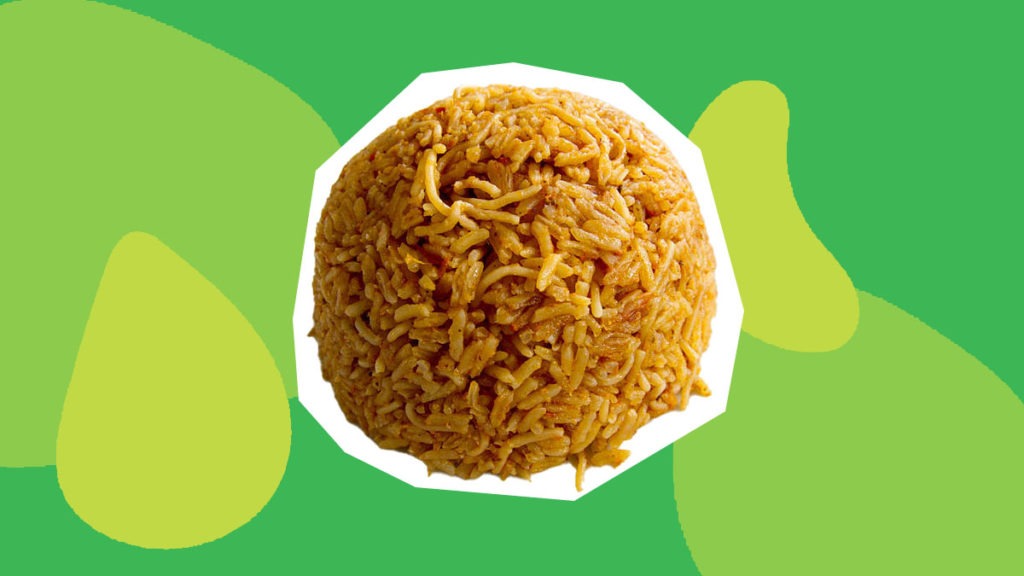Not all heroes wear capes. Some heroes are packaged in plates and fly around in cutleries. Some also battle against diseases, unlike our favorite movie superheroes who fight crime in society.
This hero, called Jollof rice, originates from West Africa. It has been saving the lives of many around the world with its mouth-watering and flavor-packed taste. Jollof is also a strong warrior who fights against diseases with its abundance of protein, dietary fiber, and carbohydrates.
Jollof rice is a red rice dish made up of five main ingredients: rice, tomatoes, pepper, oil, and spices in a single pot, cooked with vegetables and a variety of meat. It is the perfect meal for a party, date, lunch, dinner, and family gatherings. In some homes, eating Jollof on Sundays is a tradition.
Beyond nourishing and satisfying one’s palette, Jollof rice has been the center of many conversations. In October 2020, the phrase “how to prepare Jollof” was one of the most searched questions in the West African country, Nigeria. Moreover, “Jollof Wars” has been a recurring internet trend with debates on which country made the best Jollof. While Nigeria and Ghana always lead this conversation, other West African countries such as Liberia, Sierra Leone, The Gambia, and Senegal sometimes joined the discourse. It has also been endorsed as one of the best dishes by many Black celebrities such as Keri Hilson, Akon, Cardi B, and many more.
The Genesis
This delicacy has been in existence for centuries, reportedly dating back to the 1300s in the ancient Wolof Empire, which consisted of today’s Senegal, Gambia, and southern Mauritania. It originated from regions where rice was grown, as a dish named Thieboudienne. An unplanned invention, Thieboudienne stemmed out of a shortage of barley. This prompted Penda Mbaye, a local hairdresser, to use rice as a substitute for the imported cereal grain.
Jollof is said to have spread as the Wolof people moved and settled in different parts of West Africa. Others attribute its disperse to the Djula tradespeople from Mali who moved to regional, commercial, and urban centers.
Fast-forward to today; the spicy dish is a relish to people around the globe. Some historians cite it as the source of the American Creole dish, Jambalaya.
World Jollof Day and Festivals
Jollof rice is one of the few West African dishes with a commemorative day. Since 2015, World Jollof Rice has been celebrated annually on August 22. It is mostly observed with people sharing pictures and videos of their preferred Jollof Rice combinations and favorite vendors. Some businesses take advantage of the season to run promotions and engage in charity.
On World Jollof Day, festivals, exhibitions, cooking competitions, cooking classes, and parties are also held. Notable events include the Onga Jollof Battle between Nigerian and Ghanaian chefs. After a series of preliminary competitions, chefs from each country are selected to represent their countries and show off their culinary skills. The Jollof Wars and Day Party in Houston is another highlight of World Jollof Day. This involves a number of West African countries contending for the bragging rights. Africa in London – London Jollof Rice Day Fest is the ultimate event for residents of London. Here, participants get to interact with African food experts and taste the delicacy as prepared by restaurants in London.
The Different Versions of Jollof
The name and preparation of Jollof rice vary in each country. In most English-speaking countries, it is referred to as Jollof rice and Riz Gras in French-speaking countries. However, there are country-specific names.
In Senegal and The Gambia, Jollof rice is known as Thieboudienne or Ceebu Jen and Benachin respectively. There are two variants of Senegalese and Gambian Jollof: red and white. Both countries use vegetable chunks in the preparation of the dish.
Liberians, on the other hand, prefer juicy Jollof rice with more stew and oil. Additionally, every ingredient (vegetable and animal protein) is mixed in one pot before serving compared to other countries whose Jollof rice goes with side dishes. For their neighbors, Sierra Leone, one distinctive feature of their Jollof rice is the lack of fresh tomatoes. They rely solely on tomato puree for the redness of the Jollof. Others alternatively add cubed tomatoes as a garnish.
For brother countries, Nigeria and Ghana, with similarities in many aspects, their styles of Jollof rice are significantly different. Nigerians mostly parboil the rice before mixing it with the other ingredients, which is not the case for Ghanaians. Nigerians make their Jollof rice spicier than that of Ghanaians and do not eat it with any accompanying sauce, unlike their Ghanaian counterparts who occasionally eat it with Shito (a black spicy sauce).
After a long journey in a cooking pot, Jollof not only brings peace and happiness to its consumers but unites. Which variant of Jollof rice have you tasted?
Looking for more from Formation? Check out our article on 5 quick and easy protective hairstyles here!




